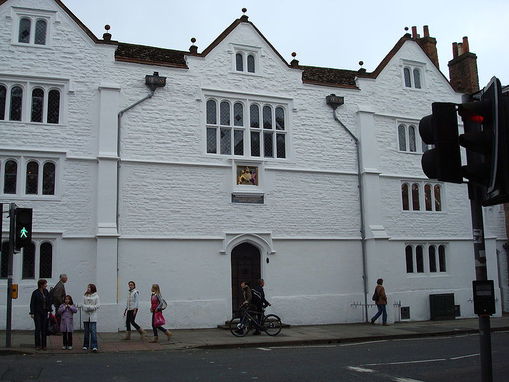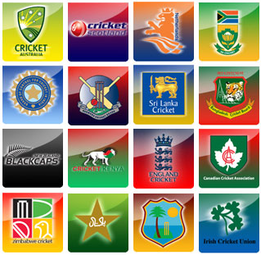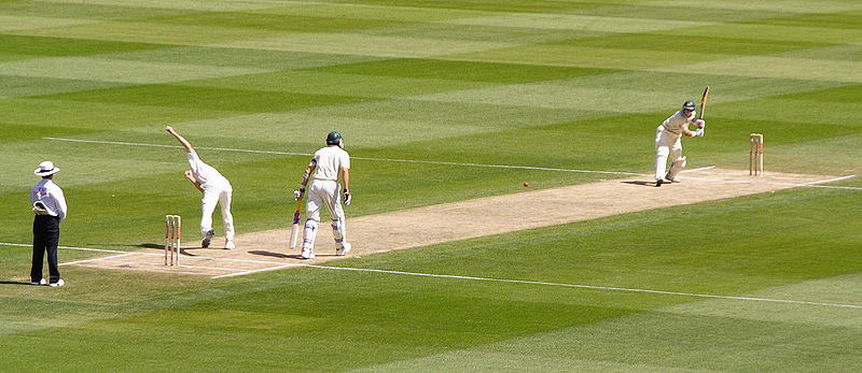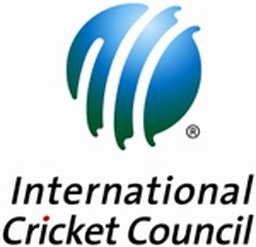Cricket
Quick FactsHighest governing body International Cricket Council
Nickname(s) "The Gentleman's game" First played 16th century (modern) Characteristics Team members 11 players per side substitute fielders (only) are permitted in cases of injury or illness Mixed gender Single Categorization Team, Bat-and-ball Equipment Cricket ball, cricket bat,wicket: stumps, bails Venue Cricket field Olympic 1900 Summer Olympics only |
Cricket is a bat-and-ball team sport. Many variations exist, with its most popular form played on an oval-shaped outdoor arena known as a cricket field at the centre of which is a rectangular 22-yard (20.12 m) long pitch that is the focus of the game. A game (or match) is contested between two teams of eleven players each. One team bats, trying to score as many runs as possible while the other team bowls and fields, trying to dismiss the batsmen and thus limit the runs scored by the batting team. A run is scored by the striking batsman hitting the ball with his bat, running to the opposite end of the pitch and touching the crease there without being dismissed. The teams switch between batting and fielding at the end of an innings.
There are also variations in the length of a game of cricket. In professional cricket this ranges from a limit of 20 overs per side (Twenty20) to a game played over 5 days (Test cricket, which is the highest level of the game). Depending on the form of the match being played, there are different rules that govern how a game is won, lost, drawn or tied. The rules of two-innings games are known as the Laws of Cricket and maintained by the International Cricket Council (ICC) (Highest governing body) and the Marylebone Cricket Club (MCC); additional Standard Playing Conditions for Test matches and One Day Internationals augment these laws. In one version of Indoor Cricket, matches include just 6 players per side and include two 12-over innings.
Cricket was first documented as being played in southern England in the 16th century. By the end of the 18th century, it had developed to the point where it had become the national sport of England. The expansion of the British Empire led to cricket being played overseas and by the mid-19th century the first international matches were being held. The ICC is the game's governing body and currently has 105 member countries.Cricket is most popular in the Test playing countries.
There are also variations in the length of a game of cricket. In professional cricket this ranges from a limit of 20 overs per side (Twenty20) to a game played over 5 days (Test cricket, which is the highest level of the game). Depending on the form of the match being played, there are different rules that govern how a game is won, lost, drawn or tied. The rules of two-innings games are known as the Laws of Cricket and maintained by the International Cricket Council (ICC) (Highest governing body) and the Marylebone Cricket Club (MCC); additional Standard Playing Conditions for Test matches and One Day Internationals augment these laws. In one version of Indoor Cricket, matches include just 6 players per side and include two 12-over innings.
Cricket was first documented as being played in southern England in the 16th century. By the end of the 18th century, it had developed to the point where it had become the national sport of England. The expansion of the British Empire led to cricket being played overseas and by the mid-19th century the first international matches were being held. The ICC is the game's governing body and currently has 105 member countries.Cricket is most popular in the Test playing countries.
History of Cricket

The Royal Grammar School, Guildford, was the site for cricket's earliest definite reference
Early cricket was at some time or another described as "a club striking a ball (like) the ancient games of club-ball, stool-ball, trap-ball, stob-ball".Cricket can definitely be traced back to Tudor times in early 16th-century England. Written evidence exists of a game known as creag being played by Prince Edward, the son of Edward I (Longshanks), at Newenden, Kent in 1301 and there has been speculation, but no evidence, that this was a form of cricket.
A number of other words have been suggested as sources for the term "cricket". In the earliest definite reference to the sport in 1598,it is called creckett. Given the strong medieval trade connections between south-east England and the County of Flanders when the latter belonged to the Duchy of Burgundy, the name may have been derived from the Middle Dutch krick(-e), meaning a stick (crook); or the Old English cricc or cryce meaning a crutch or staff.In Old French, the word criquet seems to have meant a kind of club or stick.In Samuel Johnson's Dictionary, he derived cricket from "cryce, Saxon, a stick". Another possible source is the Middle Dutch word krickstoel, meaning a long low stool used for kneeling in church and which resembled the long low wicket with two stumps used in early cricket.According to Heiner Gillmeister, a European language expert of Bonn University, "cricket" derives from the Middle Dutch phrase for hockey, met de (krik ket)sen (i.e., "with the stick chase").Dr Gillmeister believes that not only the name but the sport itself is of Flemish origin.
In 1598, a court case referred to a sport called creckett being played by boys at the Royal Grammar School, Guildford around 1550. This is the sport's earliest definite mention. It is believed that it was originally a children's game but references around 1610 indicate that adults had started playing it and the earliest reference to inter-parish or village cricket occurs soon afterwards. In 1624, a player called Jasper Vinall was killed when he was struck on the head during a match between two parish teams in Sussex.
During the 17th century, numerous references indicate the growth of cricket in the south-east of England. By the end of the century, it had become an organised activity being played for high stakes and it is believed that the first professionals appeared in the years following the Restoration in 1660. A newspaper report survives of "A great cricket match" with eleven players a side that was played for high stakes in Sussex in 1697 and this is the earliest known reference to a cricket match of such importance.
The game underwent major development in the 18th century and became the national sport of England. Betting played a major part in that development with rich patrons forming their own "Select XIs". Cricket was prominent in London as early as 1707 and large crowds flocked to matches on the Artillery Ground in Finsbury. The single wicket form of the sport attracted huge crowds and wagers to match. Bowling evolved around 1760 when bowlers began to pitch the ball instead of rolling or skimming it towards the batsman. This caused a revolution in bat design because, to deal with the bouncing ball, it was necessary to introduce the modern straight bat in place of the old "Hockey stick" shape. The Hambledon Club was founded in the 1760s and, for the next 20 years until the formation of MCC and the opening of Lord's Old Ground in 1787, Hambledon was both the game's greatest club and its focal point. MCC quickly became the sport's premier club and the custodian of the Laws of Cricket. New Laws introduced in the latter part of the 18th century included the three stump wicket and leg before wicket (lbw).
Don Bradman had a Test average of 99.94 and an overall first-class average of 95.14, records unmatched by any other player.
The 19th century saw underarm bowling replaced by first roundarm and then overarm bowling. Both developments were controversial. Organisation of the game at county level led to the creation of the county clubs, starting with Sussex CCC in 1839, which ultimately formed the official County Championship in 1890. Meanwhile, the British Empire had been instrumental in spreading the game overseas and by the middle of the 19th century it had become well established in India, North America, the Caribbean, South Africa, Australia and New Zealand. In 1844, the first international cricket match took place between the United States and Canada (Although neither has ever been ranked as a Test-playing nation).
In 1859, a team of England players went on the first overseas tour (To North America) and in 1862, an English team made the first tour of Australia. In 1876–77, an England team took part in the first-ever Test match at the Melbourne Cricket Ground against Australia.
W G Grace started his long career in 1865; his career is often said to have revolutionised the sport.The rivalry between England and Australia gave birth to The Ashes in 1882 and this has remained Test cricket's most famous contest. Test cricket began to expand in 1888–89 when South Africa played England. The last two decades before the First World War have been called the "Golden Age of cricket". It is a nostalgic name prompted by the collective sense of loss resulting from the war, but the period did produce some great players and memorable matches, especially as organised competition at county and Test level developed.
The inter-war years were dominated by one player: Australia's Don Bradman, statistically the greatest batsman of all time. It was the determination of the England team to overcome his skill that brought about the infamous Bodyline series in 1932–33, particularly from the accurate short-pitched bowling of Harold Larwood. Test cricket continued to expand during the 20th century with the addition of the West Indies, India, and New Zealand before the Second World War and then Pakistan, Sri Lanka, and Bangladesh in the post-war period. However, South Africa was banned from international cricket from 1970 to 1992 because of its government's apartheid policy.
Cricket entered a new era in 1963 when English counties introduced the limited overs variant. As it was sure to produce a result, limited overs cricket was lucrative and the number of matches increased. The first Limited Overs International was played in 1971. The governing International Cricket Council (ICC) saw its potential and staged the first limited overs Cricket World Cup in 1975. In the 21st century, a new limited overs form, Twenty20 has made an immediate impact.
A number of other words have been suggested as sources for the term "cricket". In the earliest definite reference to the sport in 1598,it is called creckett. Given the strong medieval trade connections between south-east England and the County of Flanders when the latter belonged to the Duchy of Burgundy, the name may have been derived from the Middle Dutch krick(-e), meaning a stick (crook); or the Old English cricc or cryce meaning a crutch or staff.In Old French, the word criquet seems to have meant a kind of club or stick.In Samuel Johnson's Dictionary, he derived cricket from "cryce, Saxon, a stick". Another possible source is the Middle Dutch word krickstoel, meaning a long low stool used for kneeling in church and which resembled the long low wicket with two stumps used in early cricket.According to Heiner Gillmeister, a European language expert of Bonn University, "cricket" derives from the Middle Dutch phrase for hockey, met de (krik ket)sen (i.e., "with the stick chase").Dr Gillmeister believes that not only the name but the sport itself is of Flemish origin.
In 1598, a court case referred to a sport called creckett being played by boys at the Royal Grammar School, Guildford around 1550. This is the sport's earliest definite mention. It is believed that it was originally a children's game but references around 1610 indicate that adults had started playing it and the earliest reference to inter-parish or village cricket occurs soon afterwards. In 1624, a player called Jasper Vinall was killed when he was struck on the head during a match between two parish teams in Sussex.
During the 17th century, numerous references indicate the growth of cricket in the south-east of England. By the end of the century, it had become an organised activity being played for high stakes and it is believed that the first professionals appeared in the years following the Restoration in 1660. A newspaper report survives of "A great cricket match" with eleven players a side that was played for high stakes in Sussex in 1697 and this is the earliest known reference to a cricket match of such importance.
The game underwent major development in the 18th century and became the national sport of England. Betting played a major part in that development with rich patrons forming their own "Select XIs". Cricket was prominent in London as early as 1707 and large crowds flocked to matches on the Artillery Ground in Finsbury. The single wicket form of the sport attracted huge crowds and wagers to match. Bowling evolved around 1760 when bowlers began to pitch the ball instead of rolling or skimming it towards the batsman. This caused a revolution in bat design because, to deal with the bouncing ball, it was necessary to introduce the modern straight bat in place of the old "Hockey stick" shape. The Hambledon Club was founded in the 1760s and, for the next 20 years until the formation of MCC and the opening of Lord's Old Ground in 1787, Hambledon was both the game's greatest club and its focal point. MCC quickly became the sport's premier club and the custodian of the Laws of Cricket. New Laws introduced in the latter part of the 18th century included the three stump wicket and leg before wicket (lbw).
Don Bradman had a Test average of 99.94 and an overall first-class average of 95.14, records unmatched by any other player.
The 19th century saw underarm bowling replaced by first roundarm and then overarm bowling. Both developments were controversial. Organisation of the game at county level led to the creation of the county clubs, starting with Sussex CCC in 1839, which ultimately formed the official County Championship in 1890. Meanwhile, the British Empire had been instrumental in spreading the game overseas and by the middle of the 19th century it had become well established in India, North America, the Caribbean, South Africa, Australia and New Zealand. In 1844, the first international cricket match took place between the United States and Canada (Although neither has ever been ranked as a Test-playing nation).
In 1859, a team of England players went on the first overseas tour (To North America) and in 1862, an English team made the first tour of Australia. In 1876–77, an England team took part in the first-ever Test match at the Melbourne Cricket Ground against Australia.
W G Grace started his long career in 1865; his career is often said to have revolutionised the sport.The rivalry between England and Australia gave birth to The Ashes in 1882 and this has remained Test cricket's most famous contest. Test cricket began to expand in 1888–89 when South Africa played England. The last two decades before the First World War have been called the "Golden Age of cricket". It is a nostalgic name prompted by the collective sense of loss resulting from the war, but the period did produce some great players and memorable matches, especially as organised competition at county and Test level developed.
The inter-war years were dominated by one player: Australia's Don Bradman, statistically the greatest batsman of all time. It was the determination of the England team to overcome his skill that brought about the infamous Bodyline series in 1932–33, particularly from the accurate short-pitched bowling of Harold Larwood. Test cricket continued to expand during the 20th century with the addition of the West Indies, India, and New Zealand before the Second World War and then Pakistan, Sri Lanka, and Bangladesh in the post-war period. However, South Africa was banned from international cricket from 1970 to 1992 because of its government's apartheid policy.
Cricket entered a new era in 1963 when English counties introduced the limited overs variant. As it was sure to produce a result, limited overs cricket was lucrative and the number of matches increased. The first Limited Overs International was played in 1971. The governing International Cricket Council (ICC) saw its potential and staged the first limited overs Cricket World Cup in 1975. In the 21st century, a new limited overs form, Twenty20 has made an immediate impact.
Where cricket is played?

Cricket is popular in many countries, mostly in Commonwealth countries.
The countries where cricket is most popular compete in international matches (Games between countries) that last up to 5 days, which are called test matches. Those countries are England, Australia, West Indies, South Africa, New Zealand, India, Pakistan, Bangladesh, and Sri Lanka. West Indies are a group of Caribbean countries that play together as a team. Several other countries have more junior status. The test match idea was invented by teams from England and Australia in the 19th century.
Cricket is also played in Kenya, Canada, Bermuda, Ireland, Scotland, Holland; the national teams of those countries can play one-day international matches, but do not play test matches. Zimbabwe does not play international cricket at present. Pakistan is not able to play international cricket at home at present (for security reasons).
The countries where cricket is most popular compete in international matches (Games between countries) that last up to 5 days, which are called test matches. Those countries are England, Australia, West Indies, South Africa, New Zealand, India, Pakistan, Bangladesh, and Sri Lanka. West Indies are a group of Caribbean countries that play together as a team. Several other countries have more junior status. The test match idea was invented by teams from England and Australia in the 19th century.
Cricket is also played in Kenya, Canada, Bermuda, Ireland, Scotland, Holland; the national teams of those countries can play one-day international matches, but do not play test matches. Zimbabwe does not play international cricket at present. Pakistan is not able to play international cricket at home at present (for security reasons).
Rules and Game-play
There are two teams. The team bowling has 11 players on the field. The team batting always has two people on the field.
The Captain of the bowling team chooses a bowler from his team; the other 10 players are called fielders. The bowler is trying to aim the ball at a wicket, which is made up of three sticks (called stumps) stuck into the earth, with two small sticks (called bails) balanced on them. One of the fielders, called the wicket keeper, stands behind the wicket to catch the ball if the bowler misses the wicket. The other fielders chase the ball after the batsman has hit it.
The bowler runs towards his wicket, and bowls towards the batsman at the other wicket. He does not throw the ball. He bowls the ball overarm with a straight arm. An 'over' is six balls meaning he bowls six times. Then another player becomes the bowler for the next over, and bowls from the other end, and so on. The same bowler cannot bowl two overs one after the other.
The batsman is trying to defend the wicket from getting hit with the ball. He does this with a bat. When he hits the ball with his bat, he may run toward the other wicket. To score a run, the two batsmen must both run from their wicket to the other wicket, as many times as they can. If the ball leaves the field after being hit without bouncing, six runs are scored. If the ball rolls or bounces out, whether or not the batter hit it, it counts as four runs.
There are different ways that a batsman can get out. The most common ways are:
In a one-day game, each side has one innings, and innings are limited to a certain number of overs. In longer formats each side has two innings, and there is no specific limit to the number of overs in an innings.
The Captain of the bowling team chooses a bowler from his team; the other 10 players are called fielders. The bowler is trying to aim the ball at a wicket, which is made up of three sticks (called stumps) stuck into the earth, with two small sticks (called bails) balanced on them. One of the fielders, called the wicket keeper, stands behind the wicket to catch the ball if the bowler misses the wicket. The other fielders chase the ball after the batsman has hit it.
The bowler runs towards his wicket, and bowls towards the batsman at the other wicket. He does not throw the ball. He bowls the ball overarm with a straight arm. An 'over' is six balls meaning he bowls six times. Then another player becomes the bowler for the next over, and bowls from the other end, and so on. The same bowler cannot bowl two overs one after the other.
The batsman is trying to defend the wicket from getting hit with the ball. He does this with a bat. When he hits the ball with his bat, he may run toward the other wicket. To score a run, the two batsmen must both run from their wicket to the other wicket, as many times as they can. If the ball leaves the field after being hit without bouncing, six runs are scored. If the ball rolls or bounces out, whether or not the batter hit it, it counts as four runs.
There are different ways that a batsman can get out. The most common ways are:
- The batsman misses the ball and it hits the wicket: called bowled.
- The ball hits the batsman's body when it would have hit the wicket otherwise. Called LBW (leg before wicket). The way this rule is applied is complicated; this is just the general idea.
- A fielder catches the ball after the batsman hits it, and before it bounces or leaves the field: called caught.
- While the batsmen are running, a fielder can throw the ball at the wicket. If the batsmen cannot finish the run, the batsman nearer to the wicket that is hit is out: called run out.
In a one-day game, each side has one innings, and innings are limited to a certain number of overs. In longer formats each side has two innings, and there is no specific limit to the number of overs in an innings.
Averages
In cricket there are two special kinds of average, used to measure how good a player is:
- A batsman's batting average is the number of runs he has scored in a period (such as a year or his whole career), divided by the number of times he was got out in the same period. A good batsman has a high batting average.
- A bowler's bowling average is the number of runs that have been scored while he was bowling, in a period, divided by the number of batsmen he has got out in the same period. A good bowler has a low bowling average.



